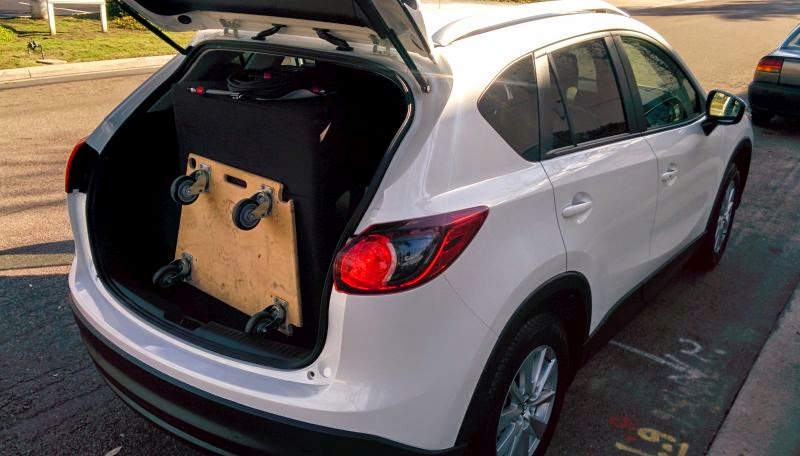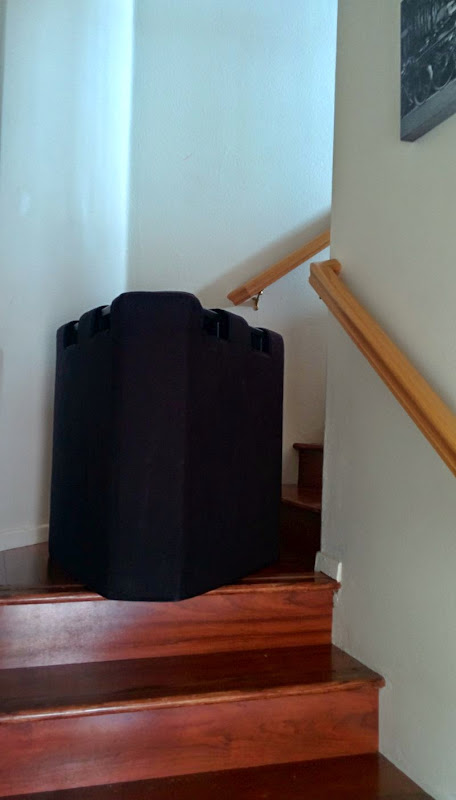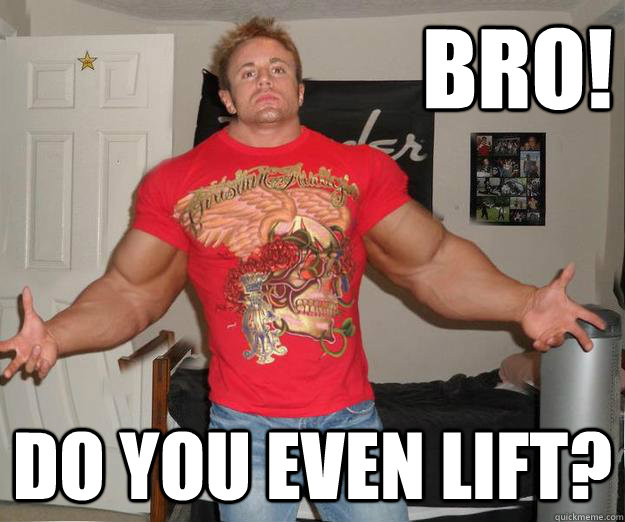I'm sure we could argue about characterizations of them, but I definitely know the two competing, um, "strategies" I'd call them that you're talking about, because I can't toss out either as a bad idea and I've been thinking about it often for several years now. (btw, I've also been thinking about bi- and tri-corner point and line sources as a third strategy but, well, I haven't managed to build/hear any yet).I hope you guys see where I'm going with this. What I'm describing is two competing philosophies. In the first philosophy, you basically create fake ambience by bouncing sound off the walls of the room. In the second scenario, the room seems to disappear, but you're head is basically locked in a vise.
I used to have a big Magnepan setup in my living room, and, well, you know the typical non-geek guest reaction to hifi stuff, ranging from the "hey that sounds pretty good, not that I'm interested in why/how/etc." to complete disinterest? That setup routinely dropped every sort of person's jaw the second I turned it up. It wasn't very accurate, and its imaging was not stable with frequency nor listener location, but it sounded tangible, 3D, just somehow real, reliably. With #2, you don't get that except with the rare exceptional recording here and there (I'm not saying "best", because I'm not sure that's true or, probably more applicably, fair).
The Summas should be able to do #2 without the vice lock, since my less-well-executed versions of the same radiation pattern certainly do - much the opposite, we're talking like 15x15' areas of sharp stereo image - but it requires a pretty large space (or, always potentially, careful room treatments). But, it's still #2. I'm skeptical of your cake-eating description, tempted to attribute it to happy coincidence with the room.
P.S. As Eldam just said before me, my top priority is tonal balance, and over a decent-sized area. Still before good imaging is the lack of really distracting bad imaging (sources seeming to jump around, etc.). Both of those things make strategy #1 problematic. Not impossible, just problematic, and that's why I don't have any dipoles right now.
P.P.S. I'm also surprised by this; I would expect heading for DSP EQ after a brief session with SH50 at home, but I think probably that's just not an aspect you were talking about?But I' surprised than the high end of the SH50 is not more bright than a Vandersteen !!!! Did you match the volume when you listen both speakers to compare ? Does the room modes of the SH50 don't hide the détails or waste the tonal balance where you are listening it ?
P.P.P.S. Do we get any pics?
Last edited:
https://www.youtube.com/watch?v=KOFHFNSzTRA
Here's a video comparing the two speakers.
I'm surprised how different they sound on Youtube.
Here in the room the difference is fairly subtle.
Must be psychoacoustics; my brain is basically filtering out the boominess you hear in this youtube video.
Here's a video comparing the two speakers.
I'm surprised how different they sound on Youtube.
Here in the room the difference is fairly subtle.
Must be psychoacoustics; my brain is basically filtering out the boominess you hear in this youtube video.
The latter.
In person, I find that the bass of the Monster Massive speaker is dry and dynamic. Fairly typical of dipoles, it needs a lot of power, but the 'pitch' of the bass sounds more natural than a ported or a sealed box.
In the video, MM sounds fairly boomy.
Above 1khz, the sound of the two speakers is consistent with what you hear in the video. The SH50 seems a little bit brighter.
In person, I find that the bass of the Monster Massive speaker is dry and dynamic. Fairly typical of dipoles, it needs a lot of power, but the 'pitch' of the bass sounds more natural than a ported or a sealed box.
In the video, MM sounds fairly boomy.
Above 1khz, the sound of the two speakers is consistent with what you hear in the video. The SH50 seems a little bit brighter.
Why Summas' users says each time this speaker is needing big room ? I don't understand that because one of the Gedlee philosophy is to have a narrower radiation with a pattern which deal with rooms by avoiding too much reflexions (sorry if description is too simple).
As the 15" driver is for mid/mid-bass/upper bass (>100 hz ?) and John doesn't seem to use bass cabinet with it but still find they do too much bass/big sound: could we definite what is a minimal room size for it ?
Does the newer little brother of the Summas should be a more versatile speaker ?
Well, I'm staying on what John described before : does the synergy designs give an acceptable soundstage with more articulation (because lower mid & mid bass drivers with a better damping due to their lesser SD and standalone virtual point source & air impedance front loading because the horn (thinking of the excelent results of a Vott A7 with impacts if not with transparency in relation to non horn loaded mid-bass/mid?).
We always stay on the weakness of our listening rooms in relation to their rooms mod and dimension ? But this maybe off topic.
Let's stay on the difference between soundstage and articulation which seems to be the main John's goal ?! Is there a design which is more dynamic at all listening level ?
Do a higher dynamic is equal to more compromise with rooms due to the signal with more db level between low and high notes ?
Particulary with listening distance: bigger low and high pressure wave mode in the room would be equal to a greater difficulty of placement ? I ask myself if it's possible to have in the same room the same listening position when it comes to compare two different speakers in dynamic or design ?
It could be interresting to reccord a good room EQ at listening position then to reproduce it elswhere with digital EQ and time response in an other room (worser room than the good target room of the model) to compare two different speaker !
I'm certainly mix too much concepts without really understand it !
As the 15" driver is for mid/mid-bass/upper bass (>100 hz ?) and John doesn't seem to use bass cabinet with it but still find they do too much bass/big sound: could we definite what is a minimal room size for it ?
Does the newer little brother of the Summas should be a more versatile speaker ?
Well, I'm staying on what John described before : does the synergy designs give an acceptable soundstage with more articulation (because lower mid & mid bass drivers with a better damping due to their lesser SD and standalone virtual point source & air impedance front loading because the horn (thinking of the excelent results of a Vott A7 with impacts if not with transparency in relation to non horn loaded mid-bass/mid?).
We always stay on the weakness of our listening rooms in relation to their rooms mod and dimension ? But this maybe off topic.
Let's stay on the difference between soundstage and articulation which seems to be the main John's goal ?! Is there a design which is more dynamic at all listening level ?
Do a higher dynamic is equal to more compromise with rooms due to the signal with more db level between low and high notes ?
Particulary with listening distance: bigger low and high pressure wave mode in the room would be equal to a greater difficulty of placement ? I ask myself if it's possible to have in the same room the same listening position when it comes to compare two different speakers in dynamic or design ?
It could be interresting to reccord a good room EQ at listening position then to reproduce it elswhere with digital EQ and time response in an other room (worser room than the good target room of the model) to compare two different speaker !
I'm certainly mix too much concepts without really understand it !
Only for pinpoint stereo image in an untreated room, because the wall behind the speakers is going to be a problem if you're aiming the patterns to cross in front of the listeners as intended and the room is small. On the plus side, you're still usually going to get pretty well-balanced sound even with a lot of reflections, thanks to the directivity.Why Summas' users says each time this speaker is needing big room ?
IMO that benefit is vastly overrated when it comes to 90°-ish constant-ish-directivity designs. Compare to a typical hifi speaker with a wider pattern that smoothly narrows to 40-60° up top, and there's only less reflected sound around the upper-middle of the spectrum, not that much less, and there's more reflected sound in the higher treble.I don't understand that because one of the Gedlee philosophy is to have a narrower radiation with a pattern which deal with rooms by avoiding too much reflexions (sorry if description is too simple).
The big difference, if you ask me, is in having very similar response on- and off-axis without accepting more than typical reflections, eg. going to omnidirectional. Having a centered stereo image for off-center listeners is also pretty cool.
Patrick,
Congrats!
Is there any possibility of you measuring them and/or Summa? It will be interesting to compare their impulse responses in particular.
I'll do some, but take them with a grain of salt. I can't measure outdoors. Normally I put my speakers three meters in the air, in my living room, and measure them there. Due to the fact that my ceilings are 6 meters tall, I can usually get a semi decent measurement.
But with the Summa and the SH50, that's out of the question, because they're too heavy.
So, again, these measurements are suspect.
Anyways, here's some data.
https://www.youtube.com/watch?v=KOFHFNSzTRA
^^ This shows the sound of the SH50 and Monster Massive. In the video, MM is noticeably boomier. To my ears, not so much.

Here's a measurement of an SH50 and Monster Massive. In the measurement, I see a few things:
1) MM has more bass, note the peak at 180hz
2) The 'curve' of the two speakers is very similar. The Vifa ring radiator in MM is more extended and flatter than the BMS in the SH50
3) The midrange of the SH50 is flatter than MM
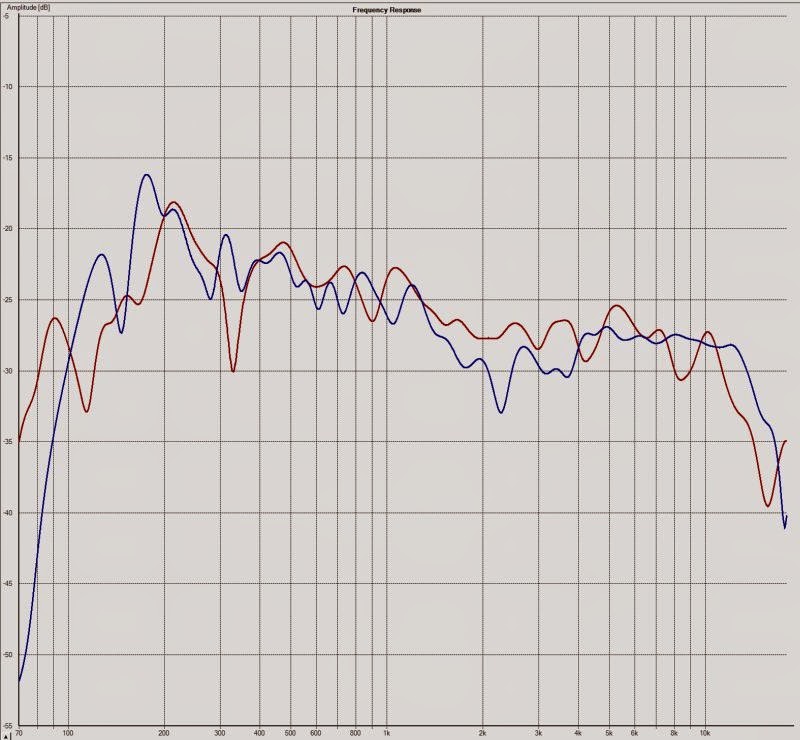
Here are the two curves, without any offset. You can see the two speakers are REAL similar. Again, I didn't have an SH50 until yesterday, so the fact that both of use wound up with the same curve is basically serendipitous. The primary difference between the two speakers in in the octave of 150-300hz and in the midrange.
I'm inclined to say that the midrange of the SH50 sounds better than Monster Massive. One thing that's a bummer is that it's not easy to raise the level from 1kz to 2khz in MM, because that raises the distortion in the tweeter (since the tweeters has an acoustive xover of about 1500hz in MM.)
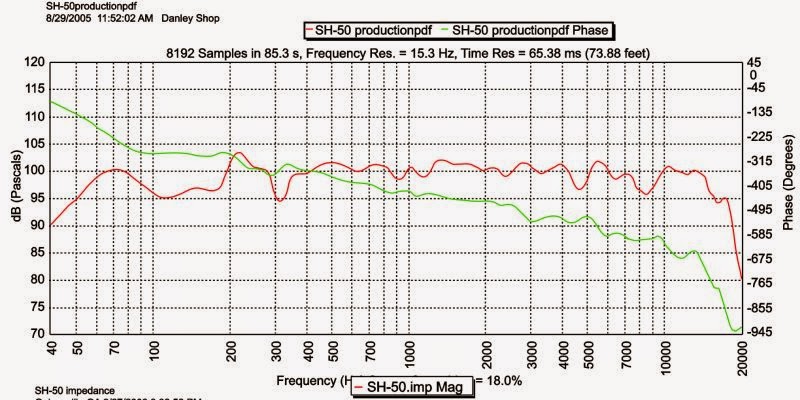
Here's the published curve of the SH50. It's quite a bit different than what I'm measuring. I'd take my measurements with a grain of salt, they're far from optimum conditions.
You said Home Depot only carried Sonotube or Sakrete concrete form tubes up to 12". Your Home Depot must be out of stock:
http://www.homedepot.com/p/SAKRETE-16-in-x-48-in-Form-Tube-65475000/100669878
My local lumber yard and the local concrete supply store each had much larger sizes too.
http://www.homedepot.com/p/SAKRETE-16-in-x-48-in-Form-Tube-65475000/100669878
My local lumber yard and the local concrete supply store each had much larger sizes too.
One thing I've learned in this project is that waveguides control directivity better than dipoles or cardioids do, and all waveguides are NOT created equal.
And also, puting a bunch of holes in a waveguide has an effect on the high frequency response.
Here's some examples:

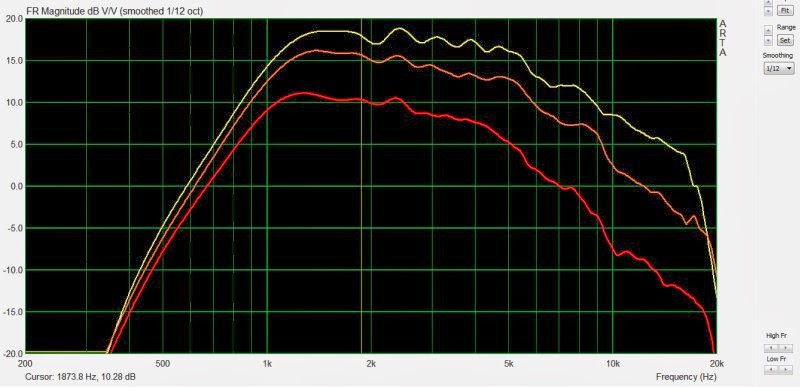
This is a pic and the polars of the $35 QSC waveguide. It's about as good as it gets. The JBL used in the econowave is very good too. Measurements from one year ago, post number 82.
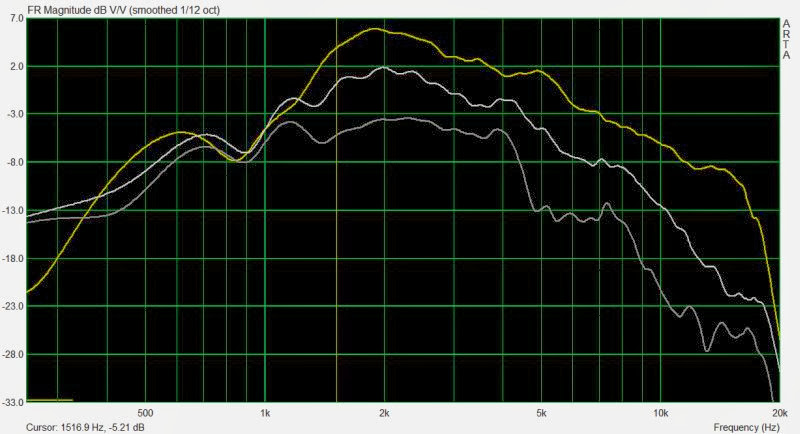
Here's the same waveguide, but with midranges on the horn. We see the F3 goes down, but there's also a significant degradation of the high frequency response.

This is the waveguide on Monster Massive, circa now

This is the response of woofer, midranges, and tweeter. Note that the midranges are basically a 'filler' driver, covering just one octave.

Here's the polars. We see the waveguide is doing what it's supposed to do, but things get a little weird as we go dipole. In particular, there's a lot of comb filtering.
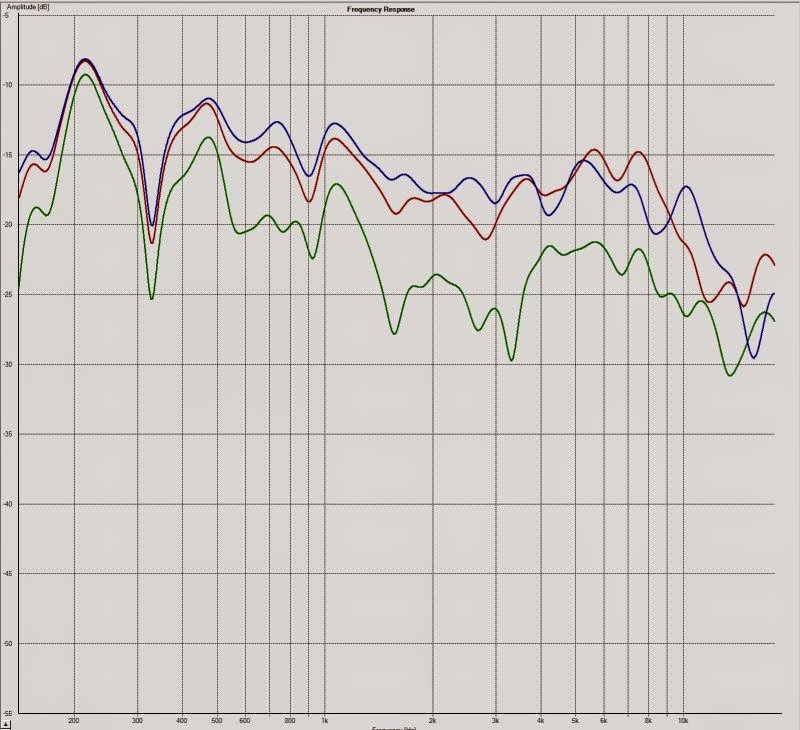
Here's the polars of the SH50. We see that waveguides control directivity better than dipoles. The crazy amounts of comb filtering seen in the dipole is absent in the SH50.
And also, puting a bunch of holes in a waveguide has an effect on the high frequency response.
Here's some examples:


This is a pic and the polars of the $35 QSC waveguide. It's about as good as it gets. The JBL used in the econowave is very good too. Measurements from one year ago, post number 82.

Here's the same waveguide, but with midranges on the horn. We see the F3 goes down, but there's also a significant degradation of the high frequency response.
This is the waveguide on Monster Massive, circa now

This is the response of woofer, midranges, and tweeter. Note that the midranges are basically a 'filler' driver, covering just one octave.

Here's the polars. We see the waveguide is doing what it's supposed to do, but things get a little weird as we go dipole. In particular, there's a lot of comb filtering.

Here's the polars of the SH50. We see that waveguides control directivity better than dipoles. The crazy amounts of comb filtering seen in the dipole is absent in the SH50.

Here's the phase response of Monster Massive

Here's the meaused phase of the SH50

Here's the published phase of the SH50
Some observations:
1) In the four octaves from 400hz to 6.4khz, the phase response of MM and SH50 are quite similar. I've noticed that if you use the right rolloff and you get the midranges within 1/4 wavelength at the crossover point, it's pretty easy to get the phase right. MiniDSP makes life much easier. I flattened the phase of MM by tweaking the arrival time of the midranges via digital delay. You can't do this easily without DSP.
2) The scale on the published measurements is dramatically different than what I used, so pay attention to that when making comparisons.
Actually, F it, I think it might be possible. Let me give it a try.
It's the obvious way to measure it, particularly since my ceilings are so tall (six meters)
I wonder if I can move the xmas tree out of the way, and put it back, before my wife gets home from work. (the joys of working from home.)
It's the obvious way to measure it, particularly since my ceilings are so tall (six meters)
I wonder if I can move the xmas tree out of the way, and put it back, before my wife gets home from work. (the joys of working from home.)
Couple o' boards underneath maybe? Not to be pushy, I don't feel like I need to see more SH50 measurements than what Tom's posted here and there, but I'd probably be doing it if I rented them.
If anyone ever asks why to use a waveguide, show them this measurement.
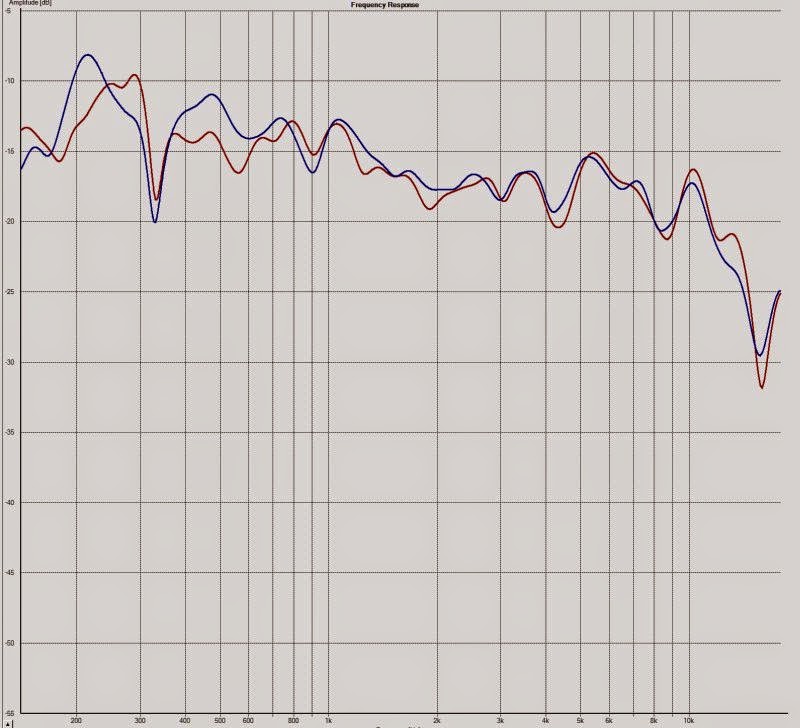
Here's a measurement of a Danley SH50 in my living room home theater.
And another measurement where I moved the xmas presents out of the way, moved a bookshelf out of the way, point the speaker up at a 16' ceiling, and measured it again.
It's basically identical
Sure, there's some low frequency reinforcement down low, but nothing that a little EQ couldn't fix.
Also, this explains why the published Danley measurements are so flat, I'm getting room gain at low frequencies.

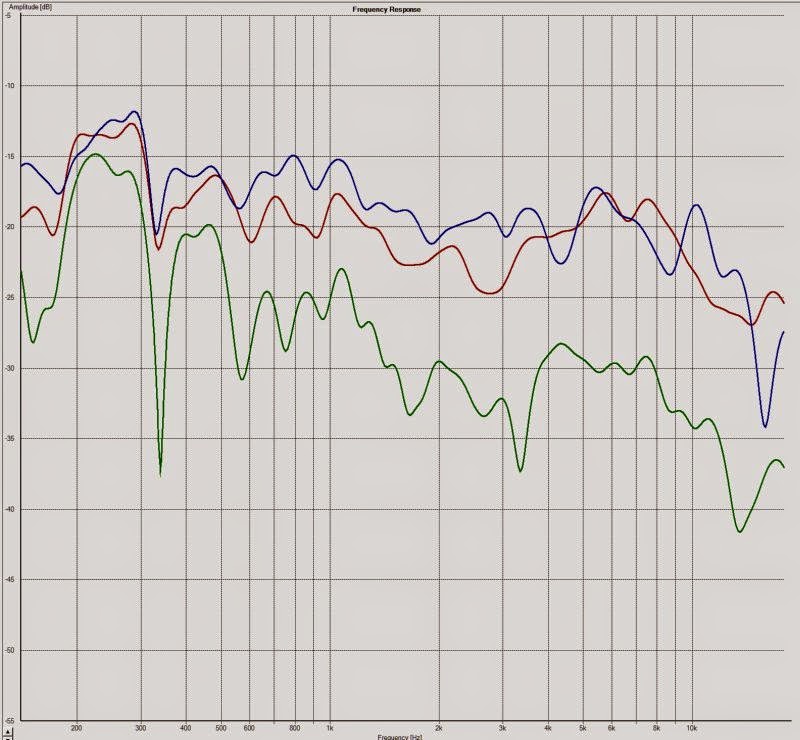
Here's some unsmoothed and smoothed polars, done in slightly more optimum conditions. Moved the SH50 into the middle of my living room, pointed it straigt up towards a 16' high ceiling.
Doesn't look a heck of a lot different than what I measured in my home theater, which is a testament to using waveguides I think.
- Status
- This old topic is closed. If you want to reopen this topic, contact a moderator using the "Report Post" button.
- Home
- Loudspeakers
- Multi-Way
- Monster Massive
